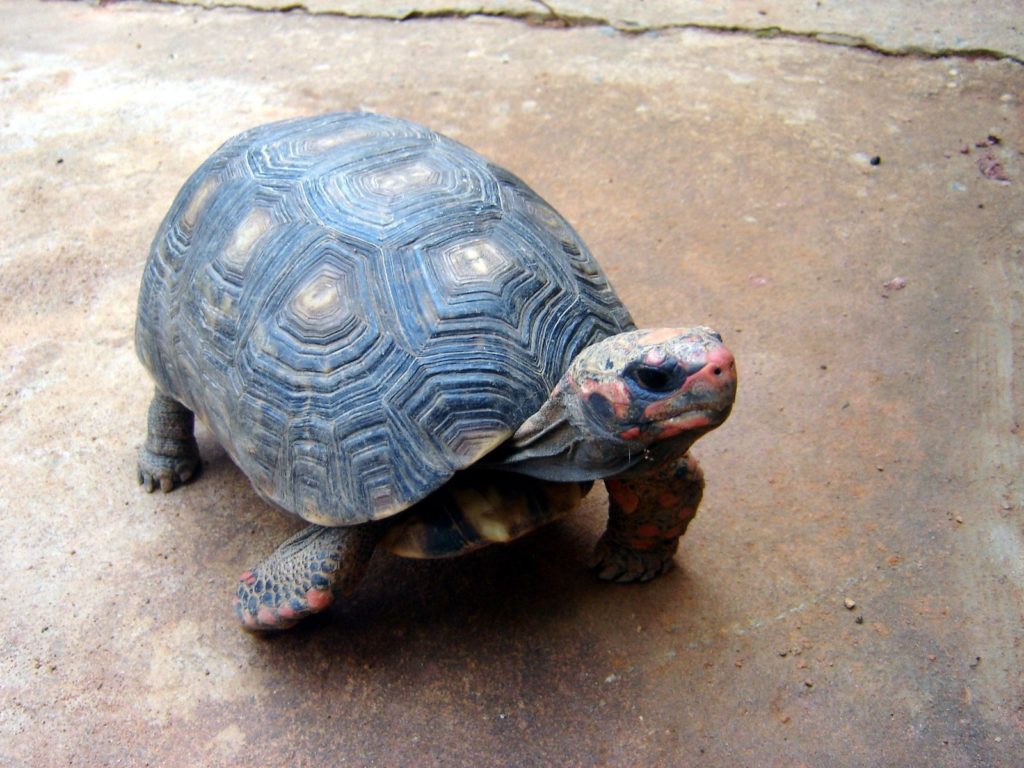ANIMAL: Red-Footed Tortoise Chelonoidis carbonaria Type of Animal: Tortoise Habitat: Open forest, savanna, forest edge, tropical forest, wood edges, waterways, forest clearings, grassland Location(s): Ranges from SE Panama to extreme N Argentina, east of Andes. Also found on some Caribbean islands in Trinidad, Tobago, Puerto Rico, Netherlands Antilles, St. Lucia, St, Vincent, Grenada, Barbados, Guadalupe, Dominica, Martinique, Leeward Islands, & Virgin Islands. Appearance: NE variant light orange to red head/limbs, plastron (bottom shell) pale yellow, black carapace (upper shell). NW variant has grey/dark brown/coffee carapace, pale yellow plastron w/ central dark areas resembling exclamation points, pale yellow to orange head/limbs. N variant pale yellow to light orange, occasionally red heads/limbs w/ similar carapace/plastron to NE variant. S variant carapace mix of almost black/dark brown w/ light grey/whitish between scutes, dark plastrons in symmetrical mottled pattern, largest variant. E variant dark plastron in symmetrical mottled pattern, heads/limbs yellowish or red, carapace light grey/whitish between scutes. Males have long muscular tail, females have short conical tail, red markings around heads/limbs, young have rounder/flatter carapaces start off pale yellow to brown, males more colorful, males have deeply indented plastron, loaf-shaped carapace in adults. Food/Diet: Leaves, greens, fruit, legumes, seed pods, vegetables, berries, cactus pads, flowers, weeds, bromeliads, poop, fungi, soil, moss, roots, shoots, eggs, carrion, rodents, insects, slugs, worms, insect larvae, shrimp, snails, small snakes Status in Wild: Threatened Conservation: Breeding from zoos, private breeders, aquariums, wildlife parks, & breeding centers. Lifestyle: Found in herds of up to 14 individuals, led by dominant male. Additional Info: Called: Male Female Young-Hatchling Group-Herd Weight: Male-20 lbs Female-15 lbs Young-1 lb Gestation: 4 months Life Span: 50-60 years Body Length: Male-13.5 in Female-11.25 in Young-3.5 in Tail Length: Male-3.5 in Female-1.5 in Main predators of adults are felids, anacondas, crocodilians, harpy eagles, dogs, & foxes. Monkeys, lizards, raptors, mongooses, opossums, coatis, rats, snakes, large turtles, curassows, guans, rails, peccaries, & skunks eat young. Threatened due to pet trade, habitat loss, hunting for meat, & egg collection. Sexually mature at 5 years old. Fun Fact(s): Known in Brazil as Jabuti & in Venezuela as Morrocoy. Captive-bred individuals can make great pets. Males cluck like chickens during courtship & mating. Considered fish by Catholic Church & consumed in huge numbers during holy week.

